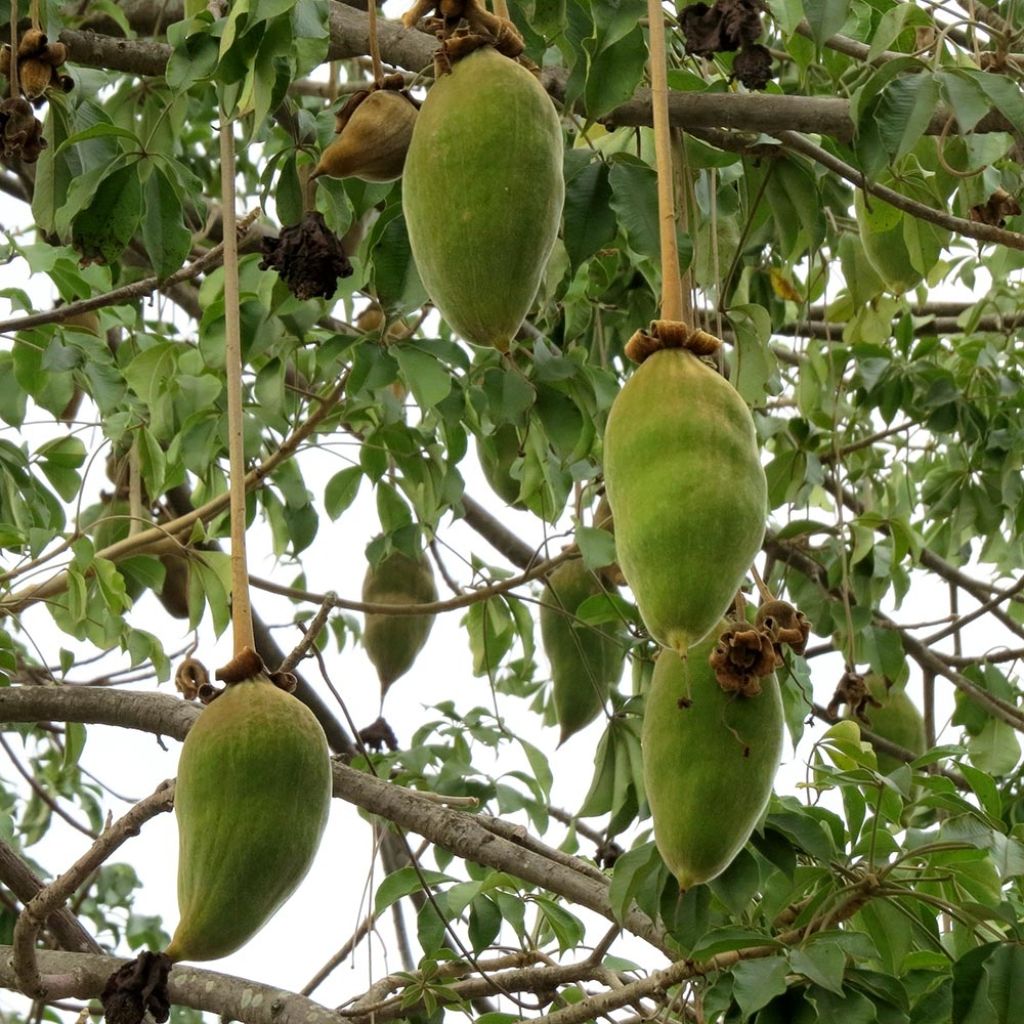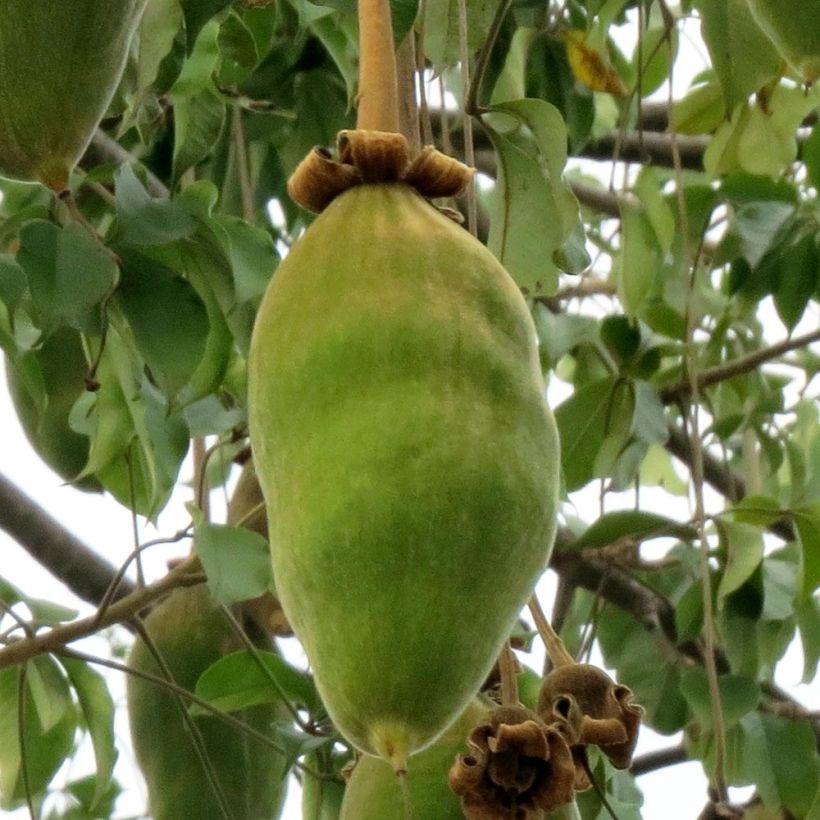

Adansonia grandidieri - Baobab de Madagascar


Adansonia grandidieri - Baobab de Madagascar


Adansonia grandidieri - Baobab de Madagascar
Adansonia grandidieri - Giant Baobab
Adansonia grandidieri
Grandidier's Baobab, Giant Baobab
This plant carries a 24 months recovery warranty
More information
We guarantee the quality of our plants for a full growing cycle, and will replace at our expense any plant that fails to recover under normal climatic and planting conditions.
From €5.90 for pickup delivery and €6.90 for home delivery
Express home delivery from €8.90.
Does this plant fit my garden?
Set up your Plantfit profile →
Description
Adansonia grandidieri, also known as the Grandidier's Baobab, is an emblematic tree of Madagascar, considered the most beautiful of the Malagasy species. Its silhouette is recognisable among all, even when the tree is grown in a pot: its extremely thick cylindrical trunk, a true colossus, supports a wide, plateau-like crown. The baobab is very sensitive to cold weather and does not flower or bear fruit in our climates, but it can be easily cultivated in containers: place it indoors from September-October to April, and take it out on the patio or balcony from May to August.
According to classifications, Adansonia grandidieri belongs to the Bombacaceae or Malvaceae family. It is a large tree endemic to the west of Madagascar, particularly abundant around Morondava, but also noticeably further south in a more compact form. The species has a specific protected status there. In nature, the Grandidier's baobab exceeds 25 m (82ft) in height, and its trunk can reach a diameter of 6 to 7 m (20 to 23ft). This very sensitive tree suffers as soon as temperatures drop below 10 or 12°C (50 or 53.6°F).
Cultivated in containers and regularly pruned, it will not exceed 2.50 m (8ft) in height with a crown span of 1.50 m (5ft). This tree develops a massive cylindrical trunk, whose soft and spongy tissues serve as water reserves during the long periods of drought it endures in its native country. The bark is thick, slightly shiny, brown in colour, becoming greyer over time. From the top of the trunk, a few large main branches branch out into increasingly thinner branches and twigs. The entire crown, spread out wide, somewhat resembles an umbrella. The foliage is deciduous during the dry season, from September-October to April in its native lands. In our climates, it will be necessary to respect this necessary resting period for the tree's health, to avoid rotting of the fleshy roots. The leaves are long-petioled, simple and entire on young specimens, but divided into 5 to 7 leaflets on adult specimens. They are dark green in colour and arranged spirally on the branches. In the wild, flowering appears on baobabs that are at least 10 years old, just before or at the beginning of the rainy season, sometimes as early as January. It takes the form of curious flowers standing on a pedicel. Each flower, 10-15 cm (4-6in) wide, consists of a white corolla surrounded by brown-green sepals topped with a cluster of pompom-like stamens, from which the pistil protrudes. It opens at night and is pollinated by lemurs and nocturnal butterflies, attracted by abundant nectar and its fragrance. After pollination, edible fruits form, oblong-round in shape, covered by a thick husk. They contain edible pulp, rich in vitamins and calcium, as well as edible oilseeds.
With its characteristic bottle-shaped silhouette, the Grandidier's Baobab is a very beautiful indoor plant, to be highlighted in a contemporary or exotic-inspired decor. Plant enthusiasts looking for unusual and beautiful plants can also adopt agaves, banana trees, or even the bird of paradise Strelitzia reginae to add a beautiful tropical touch to the patio or veranda decor.
Report an error about the product description
Adansonia grandidieri - Giant Baobab in pictures




Plant habit
Flowering
Foliage
Botanical data
Adansonia
grandidieri
Bombacaceae (Malvaceae)
Grandidier's Baobab, Giant Baobab
Madagascar
Planting and care
Plant your Baobab grandidieri all year round. It only thrives in pots or containers in our climate. The plant can spend the summer outdoors, but should be brought inside a very bright room as soon as night time temperatures drop below 10°C (50°F) (usually in September, or in October in the south of our country). Indeed, the baobab is a tree from a very hot climate, governed by two distinct seasons: the rainy season, from May to September-October, and the dry season from November to April. It cannot tolerate any frost and requires a long period of rest, in dry conditions.
The baobab requires a very well-draining, sandy or rocky soil. You can use a cactus soil mix, and a large pot measuring 30 to 40 cm (12 to 16in) in all directions, with drainage holes at the bottom. Do not place a saucer under the pot. The baobab should be placed in a very sunny location from May to September-October. Capable of storing water when available, it requires very limited and seasonal watering: once a week with a bit of fertilizer from May until the leaves fall in autumn, and no watering from November to April, when it relies on its reserves. Without a dry period, the roots will rot, leading to the death of the plant. This small tree is not bothered by the dry air in our heated homes and apartments. It tolerates pruning well, which helps to limit its growth: a short pruning of the branches allows the trunk to grow faster. By pinching the tips of the young shoots, it will branch out more quickly.
Indoors, be careful of mite attacks. Simply spray the foliage to make them disappear.
Planting period
Intended location
Care
This item has not been reviewed yet - be the first to leave a review about it.
Haven't found what you were looking for?
Hardiness is the lowest winter temperature a plant can endure without suffering serious damage or even dying. However, hardiness is affected by location (a sheltered area, such as a patio), protection (winter cover) and soil type (hardiness is improved by well-drained soil).

Photo Sharing Terms & Conditions
In order to encourage gardeners to interact and share their experiences, Promesse de fleurs offers various media enabling content to be uploaded onto its Site - in particular via the ‘Photo sharing’ module.
The User agrees to refrain from:
- Posting any content that is illegal, prejudicial, insulting, racist, inciteful to hatred, revisionist, contrary to public decency, that infringes on privacy or on the privacy rights of third parties, in particular the publicity rights of persons and goods, intellectual property rights, or the right to privacy.
- Submitting content on behalf of a third party;
- Impersonate the identity of a third party and/or publish any personal information about a third party;
In general, the User undertakes to refrain from any unethical behaviour.
All Content (in particular text, comments, files, images, photos, videos, creative works, etc.), which may be subject to property or intellectual property rights, image or other private rights, shall remain the property of the User, subject to the limited rights granted by the terms of the licence granted by Promesse de fleurs as stated below. Users are at liberty to publish or not to publish such Content on the Site, notably via the ‘Photo Sharing’ facility, and accept that this Content shall be made public and freely accessible, notably on the Internet.
Users further acknowledge, undertake to have ,and guarantee that they hold all necessary rights and permissions to publish such material on the Site, in particular with regard to the legislation in force pertaining to any privacy, property, intellectual property, image, or contractual rights, or rights of any other nature. By publishing such Content on the Site, Users acknowledge accepting full liability as publishers of the Content within the meaning of the law, and grant Promesse de fleurs, free of charge, an inclusive, worldwide licence for the said Content for the entire duration of its publication, including all reproduction, representation, up/downloading, displaying, performing, transmission, and storage rights.
Users also grant permission for their name to be linked to the Content and accept that this link may not always be made available.
By engaging in posting material, Users consent to their Content becoming automatically accessible on the Internet, in particular on other sites and/or blogs and/or web pages of the Promesse de fleurs site, including in particular social pages and the Promesse de fleurs catalogue.
Users may secure the removal of entrusted content free of charge by issuing a simple request via our contact form.
The flowering period indicated on our website applies to countries and regions located in USDA zone 8 (France, the United Kingdom, Ireland, the Netherlands, etc.)
It will vary according to where you live:
- In zones 9 to 10 (Italy, Spain, Greece, etc.), flowering will occur about 2 to 4 weeks earlier.
- In zones 6 to 7 (Germany, Poland, Slovenia, and lower mountainous regions), flowering will be delayed by 2 to 3 weeks.
- In zone 5 (Central Europe, Scandinavia), blooming will be delayed by 3 to 5 weeks.
In temperate climates, pruning of spring-flowering shrubs (forsythia, spireas, etc.) should be done just after flowering.
Pruning of summer-flowering shrubs (Indian Lilac, Perovskia, etc.) can be done in winter or spring.
In cold regions as well as with frost-sensitive plants, avoid pruning too early when severe frosts may still occur.
The planting period indicated on our website applies to countries and regions located in USDA zone 8 (France, United Kingdom, Ireland, Netherlands).
It will vary according to where you live:
- In Mediterranean zones (Marseille, Madrid, Milan, etc.), autumn and winter are the best planting periods.
- In continental zones (Strasbourg, Munich, Vienna, etc.), delay planting by 2 to 3 weeks in spring and bring it forward by 2 to 4 weeks in autumn.
- In mountainous regions (the Alps, Pyrenees, Carpathians, etc.), it is best to plant in late spring (May-June) or late summer (August-September).
The harvesting period indicated on our website applies to countries and regions in USDA zone 8 (France, England, Ireland, the Netherlands).
In colder areas (Scandinavia, Poland, Austria...) fruit and vegetable harvests are likely to be delayed by 3-4 weeks.
In warmer areas (Italy, Spain, Greece, etc.), harvesting will probably take place earlier, depending on weather conditions.
The sowing periods indicated on our website apply to countries and regions within USDA Zone 8 (France, UK, Ireland, Netherlands).
In colder areas (Scandinavia, Poland, Austria...), delay any outdoor sowing by 3-4 weeks, or sow under glass.
In warmer climes (Italy, Spain, Greece, etc.), bring outdoor sowing forward by a few weeks.


































